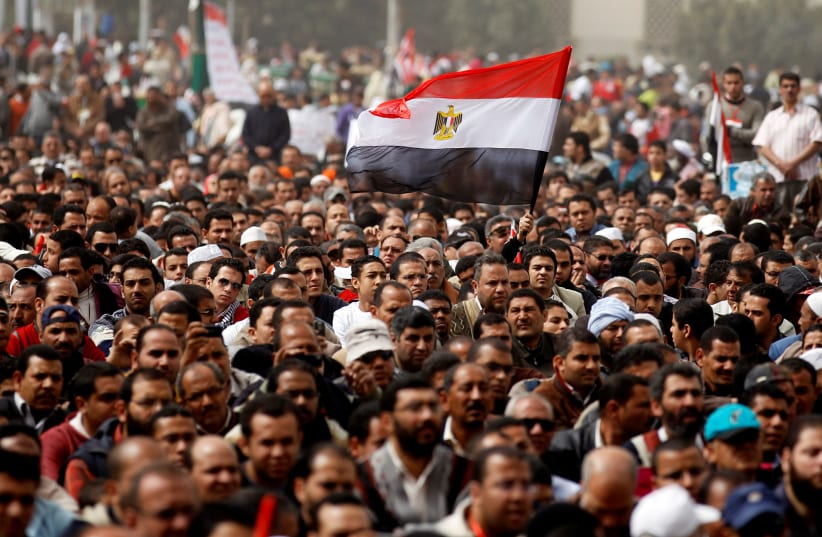TUNISIA
Fruit seller Mohammed Bouazizi set himself on fire on Dec. 17, 2010 after a local official confiscated his barrow.
Protests spread from his town, Sidi Bouzid, across the country, turning deadly. President Zine el-Abidine Ben Ali fled on Jan. 14, 2011, inspiring revolts elsewhere.
Tunisia held a first democratic election that October, won by the moderate Islamist Ennahda which had been banned under Ben Ali.
A new constitution was agreed the following year and Tunisians have regularly voted since in free national elections, most recently last year.
However, Tunisia's economy has struggled, leading to widespread disillusionment. Illegal emigration to Europe has increased and a jihadist threat remains.
EGYPT
President Hosni Mubarak had been in power since 1981, but massive anti-government protests began on Jan. 25, 2011 as activists called a "day of rage." As hundreds of thousands of protesters massed after Friday prayers three days later, Mubarak deployed the military.
Protests gathered momentum, and the army pulled its forces from the protests and Mubarak stepped down - to be tried in August on charges of abusing power and killing demonstrators.
The once-banned Muslim Brotherhood won the 2012 election but a year later the military toppled the new president, Mohamed Mursi, who was put in prison and died in 2019.
Army chief Abdel Fattah el-Sisi replaced him as president. Rights groups documented abuses in a crackdown on dissent and the military faced a long-running insurgency from Islamist militants in Sinai.
YEMEN
Crowds took to the streets against President Ali Abdullah Saleh from Jan. 29, 2011, aggravating splits in the army and between political blocs. Saleh was hurt in an assassination attempt in June 2011, forcing him to seek treatment in Saudi Arabia.
Gulf states brokered a transition deal including a "national dialog" aimed at resolving Yemen's problems, with Saleh's old deputy Abd-Rabbu Mansour Hadi to be president until elections.
With an al Qaeda insurgency raging in the east, Sanaa faced new problems in the north from the Iran-allied Houthi group and from a revived southern secessionist movement.
In 2015, after the Houthis seized Sanaa, Saudi Arabia and its allies began a military campaign to keep Hadi in power - a war that soon reached bloody stalemate, aggravating food shortages and cholera outbreaks.
LIBYA
In first Benghazi and then Misrata, protests broke out in February, 2011, soon turning to armed revolt against Muammar Gaddafi's 42-year rule.
In March, the United Nations Security Council declared a no-fly zone to protect civilians from Gaddafi's forces and NATO started air strikes to halt their advance on Benghazi.
By August, rebels had seized Tripoli and in October Gaddafi was captured hiding in a drainpipe outside his hometown of Sirte and summarily shot.
Local militias seized hold of territory and, as chaos took hold, the country split in 2014 between western and eastern factions. The U.N. helped broker a political agreement in 2015, but in practice the country stayed divided and Islamic State seized control of Sirte for more than a year.
In 2019 eastern commander Khalifa Haftar launched a new war, assaulting Tripoli for 14 months before his forces turned back. By now the conflict was international, with Russia, the UAE and Egypt backing Haftar and Turkey the Tripoli government.
BAHRAIN
On Feb. 14, 2011, the biggest protests in years erupted in Bahrain as demonstrators echoed the Egyptian crowd's call for a "day of rage" to demand the ruling monarchy grant democracy.
As protesters and police clashed over the coming weeks, sectarian tensions rose in a country where many majority Shi'ite Muslims had long chafed against the Sunni ruling dynasty.
On March 14, neighboring Sunni kingdom Saudi Arabia sent tanks across the causeway linking it to Bahrain to guard major installations. The authorities declared martial law and cleared protesters from the camp that had become their symbol.
Protests continued for months, leading to at least 35 deaths, but the monarchy suppressed the uprising and restored control.
SYRIA
When the first protests began to spread through Syria in March, 2011, President Bashar al-Assad sent in security forces and there was a wave of arrests and shootings.
By July, protesters were taking up arms and army units were joining the gathering revolt, later backed by Gulf monarchies and Turkey, as Assad hit back with air strikes. Full-blown war erupted.
As chaos engulfed the country, the Islamic State group in 2014 seized a swathe of territory and imposed its brutal rule, drawing a U.S.-led coalition to back Kurdish fighters in the northeast.
Support from Russia, Iran and Lebanon's Shi'ite Hezbollah movement helped Assad claw back control over much of the country, defeating the rebels in their big urban bases of Homs, Aleppo and Eastern Ghouta from 2015-18.
By the end of the decade, hundreds of thousands were dead and more than half the country's pre-war population was displaced with the country partitioned between Assad, Turkey-backed rebels and Kurdish-led groups.
OTHER ARAB STATES
Big protests also took place in Morocco, where King Mohammed VI ceded more powers to a democratically elected government, in Jordan and in Oman where concessions were also made.In Saudi Arabia's majority-Shi'ite Eastern Province district of Qatif, major protests were quickly put down but smaller ones continued sporadically for two years.
